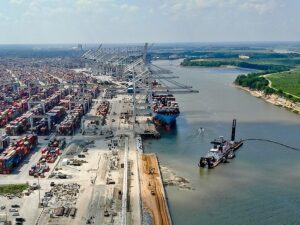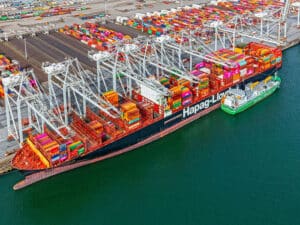
MHI confirms effectiveness of air lube system on ferry
Written by Nick Blenkey OCTOBER 8, 2012 — Japan’s Mitsubishi Heavy Industries, Ltd. (MHI) has installed its first installation of its Mitsubishi Air Lubrication System (MALS) on a ship with a slender hull form and has confirmed a better than 5 percent improvement in fuel consumption.
OCTOBER 8, 2012 — Japan’s Mitsubishi Heavy Industries, Ltd. (MHI) has installed its first installation of its Mitsubishi Air Lubrication System (MALS) on a ship with a slender hull form and has confirmed a better than 5 percent improvement in fuel consumption.
MALS is MHI’s proprietary technology that reduces frictional resistance between the ship hull and seawater by introducing a layer of air bubbles blown from the ship’s bottom.
The verification experiment was conducted at sea using the ferry Naminoue.
The 8,072 gt Naminoue is 145 m in length, 24 m wide and has a design draft of 6.2 m. Built at MHI’s Shimonoseki Shipyard & Machinery Works it went into service on September 27 on A-Line Ferry Co.’s Kagoshima-Amami-Okinawa route in southern Japan.
MHI says that service results have verified that MALS is also applicable to high-speed, slender ships as an effective way to reduce fuel consumption and reduce environmental burdens, further extending the range of ship types for which MALS is suited.
In 2010 MHI installed MALS for the first time on two module carriers operated by NYK-Hinode Line, Ltd. and confirmed significant energy savings. To expand MALS’ application range, MHI next proceeded to develop a system applicable to high-speed, slender ships, which have a comparatively smaller flat area at the ship bottom and are therefore considered technologically difficult to apply MALS effectively. Installation of the system on the Naminoue was realized thanks to the full cooperation extended by A-Line Ferry Co., Ltd.
During the speed trial test at sea, a fuel consumption improvement (reduction in propulsion power required) exceeding 5 percent was confirmed even with waves as high as 2.5 m -3 m. These results verified reduction of frictional resistance by MALS even when installed on high-speed, slender ships. The level of fuel consumption reduction is sufficient to offset the fuel consumption increase such a ship’s marine diesel engine requires to comply with tightened controls on NOx (nitrogen oxide) emissions. As the air bubbles function as a cushion, noise and vibration are also reduced, enabling improvements in passenger comfort.
MHI says it will continue to monitor the operational conditions of the Naminoue and to verify MALS’ effectiveness in both energy saving and CO2 reduction.
The verification experiment using the Naminoue was supported by Class NK (Nippon Kaiji Kyokai) as a joint research project.
Note: A slender hull-form ship refers to a ship with relatively small block coefficient (Cb). Cb = volume of displacement divided by the volume of the block defined by a ship’s length x breadth x draft. Ships with a comparatively large Cb value are known as “full hull-form ships.”





Leave a Reply
You must be logged in to post a comment.